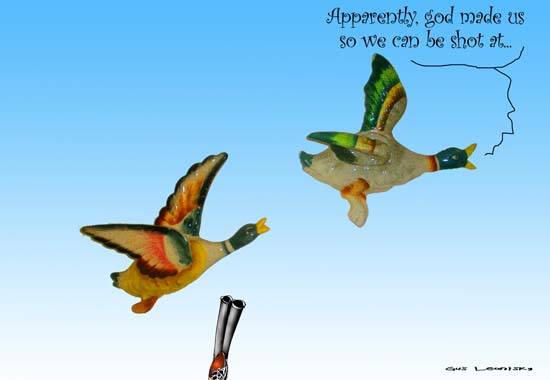Search
Recent comments
- burko boy goes burqa....
2 hours 49 min ago - singing for gaza....
7 hours 54 min ago - 2 states.....
9 hours 45 min ago - pits...
10 hours 23 min ago - jared's....
18 hours 56 min ago - domestics....
22 hours 29 min ago - straw bill....
22 hours 49 min ago - yuck...
23 hours 21 min ago - just peace....
1 day 7 hours ago - a bet....
1 day 7 hours ago
Democracy Links
Member's Off-site Blogs
landing spots becoming rarer for birds of a feather...

World Migratory Bird Day: Flying for survival
Migrating birds fly thousands of kilometers between their breeding and wintering grounds each year. And while millions pull off this spectacular feat, human activities are making their epic journeys more dangerous.
Flying on empty
Habitat loss is by far the biggest threat facing birds. Intensive farming and deforestation are making it harder for long-distance fliers to find the shelter and food they need to build strength for their taxing migration. Take the golden-winged warbler. Its numbers have dropped 60% in 50 years, partly due to land clearing for palm oil, coffee and cattle in its wintering grounds in South America.
Read more:
https://www.dw.com/en/world-migratory-bird-day-flying-for-survival/g-533...
See also:
- By Gus Leonisky at 13 May 2020 - 9:52am
- Gus Leonisky's blog
- Login or register to post comments
here today, gone tomorrow...
On 9 May 2020, people around the world will celebrate World Migratory Bird Day (WMBD) – a global campaign dedicated to raising awareness of migratory birds and the need for international cooperation to conserve them.
This year, due to the Covid-19 pandemic, many of us must stay at home. But we can reach for our binoculars to celebrate the theme of World Migratory Bird Day “Birds Connect Our World”, chosen to highlight the importance of conserving the integrity of ecosystems that support the natural cycles essential for the survival and well-being of migratory birds. The theme also underlines the fact that migratory birds are part of our shared natural heritage and they depend on a network of sites along their migration routes for breeding, feeding, resting and overwintering.
World Heritage sites such as the Migratory Bird Sanctuaries along the Coast of Yellow Sea-Bohai Gulf of China (Phase I) show us that birds literally do connect our world; the intertidal areas of the Yellow Sea/Gulf of Bohai are of global importance for the gathering of many migratory bird species that use the East Asian-Australasian flyway. Doñana National Park in Spain is home to five threatened bird species and is the wintering site for more than 500,000 water fowl each year.
All of these birds are vulnerable to the effects of climate change. Global warming is affecting the breeding areas of wading birds, and even their eating habits. Shellfish, an important food source for birds in the Wadden Sea (Germany/Denmark/Netherlands), the largest unbroken system of intertidal sand and mud flats in the world, can die en masse during heat waves. We monitor these issues and see what can be done to mediate them.
And there is good news too—earlier this year, during the 2020 international waterbird census, Banc d'Arguin National Park (Mauritania) broke all records, with a surprising count of 1.7 million waterbirds.
At UNESCO we work hard to support member states and natural World Heritage sites to assess climate vulnerability and plan climate adaptation initiatives. If birds are healthier and encounter less impacts from human activities, they will be able to cope better with the changing conditions. The more we protect our natural world, the more we all benefit.
Read more:
https://whc.unesco.org/en/news/2113